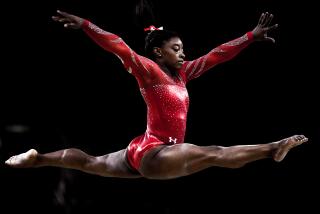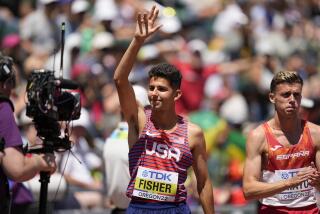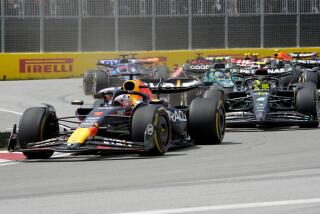U.S. Cycling Looks for Next Armstrong
- Share via
PARIS — Tom Danielson was a mountain biker. Now he’s a road racer, a member of the U.S. Discovery Channel team, a teammate of six-time Tour de France winner Lance Armstrong and grateful to America’s iconic bike racer.
“Shortly after I switched to road racing,” Danielson said, “I got a chance to meet Lance. He sat down and talked to me for a long time, told me he thought I had potential and pretty much opened up my eyes to what I can do. It was such an honor. It kind of changed my life.”
Armstrong begins the chase for his seventh consecutive Tour de France victory Saturday in Fromentine, near the Atlantic coast. This will be an attempt at record-padding for Armstrong, 33, who last summer became the first man to win six straight Tours.
And because the Texan, whose story is punctuated not only with record-setting statistics but also with his heartwarming triumph over cancer, has announced the 2005 Tour will be his final competitive race, obvious questions loom about the future of U.S. cycling.
* Will American interest wane in this foreign-dominated sport, and in a race that meanders over 22 days and covers more than 2,000 miles of unfamiliar territory?
* Is cycling in the U.S. nothing more than a periodic phenomenon reliant on singular American champions who pop up once every couple of decades?
Some nouveau U.S. fans have no idea that Armstrong isn’t the first American to win the Tour; Greg LeMond won three Tours, in 1986, ’89 and ’90.
But when LeMond retired, the Tour de France was largely forgotten by Americans until Armstrong began his streak in 1999.
The U.S. cycling cupboard is a little fuller now, with Danielson and others.
It’s even possible that were Armstrong’s streak to end this year, it might be another American who beats him.
Levi Leipheimer, a 31-year-old Montanan who will lead German team Gerolsteiner, has twice finished in the top 10 at the Tour and was a strong third at the Dauphine Libere, a key Tour prep race, last month.
Floyd Landis, 29, has taken over leadership of the Swiss team, Phonak, assuming the role previously held by Tyler Hamilton, another American, before he failed a blood doping test last summer.
Bobby Julich, 33, became the first American to win the historic Paris-Nice road race earlier this year.
But it is the next generation of riders who will be watched more closely.
Danielson, 27, climbed to victory at the Tour de Georgia in April in the biggest race on U.S. soil. Armstrong was riding in support of Danielson on the last day.
Danielson is not on Discovery’s Tour de France team because he is recovering from a back injury, but he is expected to be a key rider at the Spanish Vuelta later this summer.
David Zabriskie, 26, who won a stage at the Giro d’Italia this spring while riding for Danish team CSC, and 21-year-old amateur Tyler Farrar, along with Danielson, have been tabbed as possible future American Tour de France stars.
Jim Ochowicz, president of USA Cycling and one of the men responsible for nurturing the group of American cyclists that includes Armstrong, Julich, Leipheimer, George Hincapie and Hamilton, who have all made marks on international cycling, thinks Armstrong has made cycling a sport that will matter in the U.S. for a long time.
“Lance has given cycling legs,” Ochowicz said. “Before Lance it was like a spider. Now it’s like a centipede, legs everywhere. When Lance is gone next year, the sport will still have a lot of life left in it. The momentum will take a long time to slow down and in the meantime all of us within the sport of cycling will need to find talented younger athletes to take up Lance’s cape.”
Ochowicz believes that because of Armstrong some general sports fans can now use terms such as “peloton” in a sentence that makes sense.
“Cycling interest has expanded beyond the Tour de France,” Ochowicz said. “There are all sorts of interesting races that have gotten more publicity. That interest is not immediately going to go away when Lance leaves. Will some of the coverage pull back? Sure. But there will be a U.S. team and there is a strong group of U.S. athletes still in the picture.”
Frankie Andreu, captain of the 1999 and 2000 United States Postal Service teams, a two-time Olympian and cycling commentator for the Outdoor Life Network, agrees that the U.S. will continue to benefit from what he calls the “Lance effect.”
“Lance has made the Tour de France a household sport in the U.S.,” Andreu said, “and that’s not going away for the next five or 10 years. We’ve seen membership in USA Cycling gradually increase. There are a lot more women in the organization. These new young adults often have children who get involved in the sport.”
Gerard Bisceglia, chief executive of USA Cycling, said that organization has seen a 30% increase in the number of cyclists it has registered in the last three years.
“Lance has done for cycling what Arnold Palmer did for golf,” Bisceglia said. “He brought the sport to the general public. Prior to Lance, cycling was a niche sport and the U.S. general public was generally unaware of it.”
Bisceglia said that while LeMond’s accomplishments were amazing, “Greg was an American expatriate riding for a foreign team. Greg was an American individual who conquered a foreign sport. Lance brought the sport back to our shores.”
At junior races around the country, Bisceglia said, saturation points are continually reached in the number of riders who can compete. “Now it’s the obligation of USA Cycling to maintain what Lance has started,” he said.
If there is cause for concern it might be that Discovery Channel, the first-year sponsor of what used to be the U.S. Postal Service team, is grooming a young Ukrainian rider, 25-year-old Yaroslav Popovych, as Armstrong’s immediate successor.
Danielson is still making the transition from mountain biking to road racing and isn’t expected to be a Tour threat for another year or two. Landis, who had been seen as the likely successor to Armstrong, left the U.S. team suddenly last season for a bigger contract and more immediate responsibility at Phonak.
Armstrong worries that if it is not an American doing the winning, even on an American team, the sport may become a tough sell in the U.S.
“I suspect the American sports public prefers watching one of its own,” he said.
Dan Osipow, spokesman for the U.S. team, said the goal of team Discovery Channel is to quickly win a Tour without Armstrong at the lead -- no matter the nationality of the team leader.
“We have this whole body of knowledge, of research done in wind tunnels and about the construction of the bike, of the helmet, of the suit, that has benefited Lance and will benefit the next man to lead our team,” Osipow said. “It is no secret that we want to win a Tour after Lance to show that this team is committed to excellence.”
Which brings the story back to riders such as Danielson, who said, “I’ve sat in front of my TV like millions of other people and watched Lance. What he’s done for the sport, I don’t want to see that undone.
“We’ve got the athletes out there. It’s time for us to take Lance’s momentum. There won’t be another Lance like there won’t be another Michael Jordan. But the sport in the U.S. has a future now.”
*
(BEGIN TEXT OF INFOBOX)
Lance’s record
The performances of Lance Armstrong in the Tour de France:
1993
Rides his first Tour de France for Motorola team and wins the first of 22 stage victories at the age of 21. Armstrong does not finish the Tour, but his stage win prompts Motorola to renew its team sponsorship.
1994
Armstrong takes part in the Tour with his world champion jersey on but does not finish. Five-time Tour winner Eddy Merckx tells him he could be a Tour champion if he loses weight.
1995
Wins his second stage victory for Motorola in Limoges, two days after the fatal crash in the Pyrenees of his Italian teammate Fabio Casartelli. Armstrong points to the sky in homage to the former Olympic champion. Finishes 36th overall.
1996
Takes part in the Tour but does not finish. Three months later in October, he learns he has testicular cancer.
1999
Returns to the Tour from near-fatal cancer. Thanks to training with former Tour rider Johan Bruyneel, Armstrong is a leaner, more versatile competitor. He takes his first yellow jersey by winning the prologue in the Puy du Fou and goes on to win three more stages, two time trials in Metz and the Futuroscope theme park, as well as a mountain stage in Sestriere.
2000
Wins his second Tour despite only one stage victory in the main time trial in Freiburg. The Tour highlight is his thrilling fight with Marco Pantani on the Ventoux climb. The Texan leaves the stage victory to the Italian, a gesture he has always regretted.
2001
Four stage victories, including both time trials and a first win at l’Alpe d’Huez, lead Armstrong to tie compatriot Greg LeMond by winning three Tours.
2002
Another collection of stage wins for the man who is now the U.S. Postal Service team leader -- the prologue, one time trial in Macon and two stages in the Pyrenees (La Mongie and Plateau de Beille). Armstrong is beaten for the first time since 1999 in a long time trial in Lorient by Colombian Santiago Botero.
2003
A hard Tour for Armstrong, who struggles with stomach problems from the start. He crashes, suffers and fights hard against strong opposition from Jan Ullrich, who beats him in a time trial in Cap Decouverte. Finally takes the upper hand in a fantastic mountain ride to Luz-Ardiden to tie Jacques Anquetil, Merckx, Bernard Hinault and Miguel Indurain by winning five Tours.
2004
Six stage wins for an unprecedented sixth Tour victory. His U.S. Postal Service team wins the team time trial, and Armstrong crushes the opposition with a clean sweep of four stage wins in the Alps.
Source: Reuters


